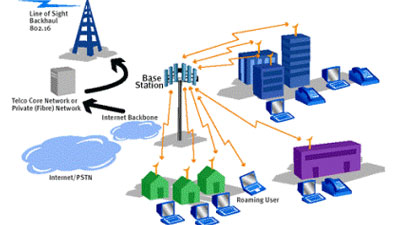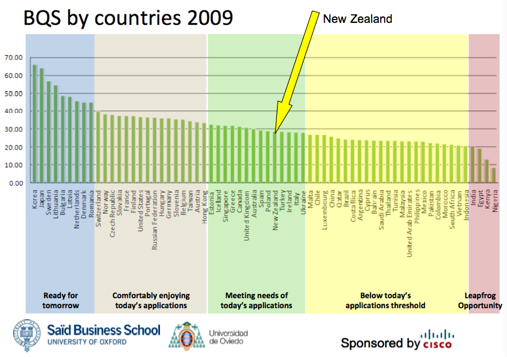The Rural Broadband scam Initiative.
New Zealand is a primary producer. Our economy still relies on what our land can produce.
The governments decision to go with a rural broadband upgrade employing our two largest Tel-co is not surprising but are they going to be able to deliver?
Hell yes!
They have set the bar so low any hack IT company could deliver these specs.
Lets look at what they are promising.
86% Peek Speed 5Mb/s - Anyone within a few kilometers of a cabinet on main roads will have this already. There is fibre in our district all the way to Waihau Bay. However Telecom does not utilise all its cabinets and its fibre. Several strands of the fibre in the ground lies unused (black fibre). Telecoms reluctance in the past to upgrading exchanges and cabinets is purely economics not technical.
A good % of rural people have access to ADSL broadband and many farmers have paid to put their own fibre cables in where feasible. The problem is always going to be the 14% of rural people that Telecoms and Vodafone are not addressing. If you are more than a few kilometers away from a Fibre Cabinet, forget about it, you will be lucky to get anything like fast broadband let alone ultrafast.
154 new cell towers - Great news, cell phone coverage has always been poor in our district. However you can now see what many rural subscribers are going to be offered - mobile broadband. The data caps, speed and costs of this option are still disadvantaging the rural consumer.  The ‘wholesale prices’ comparable to urban prices - hmmm I don’t pay wholesale I wonder what the retail cost will be. Right now the cost of Mobile broadband is a disgrace compared to other countries. Not only that, the capping and speed is dismal.
The ‘wholesale prices’ comparable to urban prices - hmmm I don’t pay wholesale I wonder what the retail cost will be. Right now the cost of Mobile broadband is a disgrace compared to other countries. Not only that, the capping and speed is dismal. Telecoms and Vodafone 4G aspirations - 4G (“4G” stands for “4th Generation” cellular network.) can provide speeds of up to 200Mb/s how ever with more traffic sharing a cell channel these speeds are really theoretical.
Its also predicted that 2014 will be the earliest date we will see real 4G services and for most rural users it will be an issue of cost. If your rural and paying $10 for dial-up how much am I willing to pay for broadband.
Ultra Fast or Ultrafast that is the question? - The government RBI with Telecoms and Vodafone use the term Ultrafast giving what they are providing in the RBI a brand for people to talk about. What does it mean?
Ultra Fast Broadband is a much abused term it can mean many things to different techies. In Japan the average broadband speed is right now 93Mb/s. NZ has an average broadband speed of 2.97Mb/s (one of the lowest in the developed world) The term Ultra Fast Broadband for present leading edge broadband projects in the UK and USA aim for 1Gb/s (1000 Mb/s).
So who is kidding who when the RBI aims for 5Mb/s peak bandwidth. Schools are being provided with 100Mb/s which is a great improvement on the existing speeds.
No one has told schools how they upgrade their infrastructure to take advantage of these new speeds. If you have a school with a 10Mb/s infrastructure nothing in the world is going to give users 100Mb/s at the desktop.
Those schools with 100Mb/s structures will get speed = 100Mb/s / #Users. You can see that the benefits could be limited by the schools ability to upgrade its IT infrastructure.
Wireless networks - Huge leap forward has taken place in the speeds of WiFi networks. The government is freeing up several frequencies used by analogue TV in the near future. (this is also a cost to the consumer as TV customers of free to air TV will have to upgrade to a digital set top box or a digital tv).
These new WiFi initiatives provide further options for rural users. In the future many hard to get to places may be able to hop on wifi links to connect to fibre networks. The speed they get will again depend on the number of users per wifi node and the environmental conditions.
6 years - IT Technology presently has a life cycle of less than three years (being generous) this means in six years everything that we know about broadband performance and the technologies at present will be obsolete. The rest of the world is moving to 1Gb/s speeds and we are struggling to get to ‘ultra slow’ broadband of 5Mb/s.
Conclusion - We should not be applauding this government and the RBI partners we should be telling them its not good enough and to aim for what most developed countries have had for years we as a country need to invest in the future network structure to make us a leading IT savvy nation with the business nonce to know it will pay off in the long run.
Telecoms and Vodafone 4G aspirations - 4G (“4G” stands for “4th Generation” cellular network.) can provide speeds of up to 200Mb/s how ever with more traffic sharing a cell channel these speeds are really theoretical.
Its also predicted that 2014 will be the earliest date we will see real 4G services and for most rural users it will be an issue of cost. If your rural and paying $10 for dial-up how much am I willing to pay for broadband.
Ultra Fast or Ultrafast that is the question? - The government RBI with Telecoms and Vodafone use the term Ultrafast giving what they are providing in the RBI a brand for people to talk about. What does it mean?
Ultra Fast Broadband is a much abused term it can mean many things to different techies. In Japan the average broadband speed is right now 93Mb/s. NZ has an average broadband speed of 2.97Mb/s (one of the lowest in the developed world) The term Ultra Fast Broadband for present leading edge broadband projects in the UK and USA aim for 1Gb/s (1000 Mb/s).
So who is kidding who when the RBI aims for 5Mb/s peak bandwidth. Schools are being provided with 100Mb/s which is a great improvement on the existing speeds.
No one has told schools how they upgrade their infrastructure to take advantage of these new speeds. If you have a school with a 10Mb/s infrastructure nothing in the world is going to give users 100Mb/s at the desktop.
Those schools with 100Mb/s structures will get speed = 100Mb/s / #Users. You can see that the benefits could be limited by the schools ability to upgrade its IT infrastructure.
Wireless networks - Huge leap forward has taken place in the speeds of WiFi networks. The government is freeing up several frequencies used by analogue TV in the near future. (this is also a cost to the consumer as TV customers of free to air TV will have to upgrade to a digital set top box or a digital tv).
These new WiFi initiatives provide further options for rural users. In the future many hard to get to places may be able to hop on wifi links to connect to fibre networks. The speed they get will again depend on the number of users per wifi node and the environmental conditions.
6 years - IT Technology presently has a life cycle of less than three years (being generous) this means in six years everything that we know about broadband performance and the technologies at present will be obsolete. The rest of the world is moving to 1Gb/s speeds and we are struggling to get to ‘ultra slow’ broadband of 5Mb/s.
Conclusion - We should not be applauding this government and the RBI partners we should be telling them its not good enough and to aim for what most developed countries have had for years we as a country need to invest in the future network structure to make us a leading IT savvy nation with the business nonce to know it will pay off in the long run.